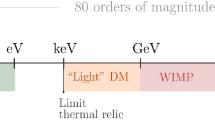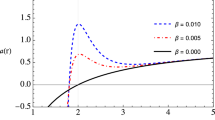Abstract
We derive several, detailed relationships in terms of the Friedmann-Robertson-Walker (FRW) generalization which describe the Universe during both the radiation and matter dominated epochs. We explicitly provide for the influence of radiation, rather than burying this term within the matter term. Several models allow the cosmological constant (CC) to vary with universe expansion in differing manners. We evaluate these and other popular models including the ΛCDM(standard model), quintessence as presented by Vishwakarma, Equation of State (EoS) and the Carmeli model with data from the 580 Union2.1 supernovae type Ia collection, using several minimization routines and find models built about the CC, the ΛCDM models, fare no better than those without.


Similar content being viewed by others
References
Sumner, T.J.: Experimental searches for dark matter. Living Rev. Relativ. 5, 4 [Online Article]: cited [2014]. http://www.livingreviews.org/lrr-2002-4 (2002)
Carroll, S.M.: The cosmological constant. Living Rev. Relativ., 3, 1 [Online Article]: cited [2014]. http://livingreviews.org/lrr-2001-1 (2001)
Will, C.M.: The confrontation between general relativity and experiment. Living Rev. Relativ. 9, 3 [Online Article]: cited [2014]. http://www.livingreviews.org/lrr-2006-3 (2006)
Shen, M.: Dark energy models in plane symmetric space-time with time varying Λ term. Int. J. Theor. Phys. 52, 178 (2013)
Sola, J.: Cosmological constant and vacuum energy: old and new ideas. arXiv:1306.1527v3 (2013)
Riess, A.G., Strolger, L.-G., Casertano, S., Ferguson, H.C., Mobasher, B., et al.: Observational evidence from supernovae for an accelerating universe and a cosmological constant. Astron. J. 116, 1009 (1998)
Perlmutter, S., Aldering, G., Goldhaber, G., Knop, R.A., Nugent, P., et al.: Measurements of omega and lambda from 42 high-redshift supernovae. Astrophys. J. 517, 565 (1999)
Suzuki, N., Rubin, D., Lidman, C., Aldering, G., Amanullah, R., et al.: The hubble space telescope cluster supernova survey. V. Improving the dark-energy constraints above z > 1 and building an early-type-hosted supernova sample. Astrophys. J. 746, 85 (2012)
Astier, P.: The expansion of the universe observed with supernovae. Rep. Prog. Phys., 75, 116901 (2012)
Calder, A.D., Krueger, B.K., Jackson, A.P., Townsley, D.M.: The influence of chemical composition on models of type Ia supernovae. arXiv:1303.2207v1 (2013)
Wang, X., Wang, L., Filippenko, A.V., Baron, E., Kromer, M.: Evidence for type Ia supernova diversity from ultraviolet observations with the hubble space telescope. Astrophys. J. 749, 126 (2012)
Kirshner, R.P.: Foundations of supernovae cosmology. arXiv:0910.0257v1 (2009)
Wang, S., Wang, Y.: Exploring the systematic uncertainties of type Ia supernovae as cosmological probes. arXiv:1306.6423v2 (2013)
Chotard, N.N., Gangler, E., Aldering, G., Antilogus, P., Aragon, C., et al.: The reddening law of type Ia supernovae: separating intrinsic variability from dust using equivalent widths. Astron. Astrophys. 529, L4 (2011)
Vishwakarma, R.G.: Consequences on variable Λ-models from distant type Ia supernovae and compact radio sources. Classical and Quantum Gravity 18, 1159 (2001)
Peebles, P.J.E., Ratra, B.: The cosmological constant and dark energy. Rev. Mod. Phys. 75, 559 (2003)
Pavluchenko, S.A.: The generality of inflation in closed cosmological models with some quintessence potentials. arXiv:astro-ph0304354v1 (2003)
Oztas, A.M., Smith, M.L.: A polytropic solution of the expanding universe - constraining relativistic and non-relativistic matter densities using astronomical results. In: Alfonso-Faus, A. (ed.) Aspects of Today’s Cosmology. Intechweb.org 51000 Rijeka, Croatia (2011)
Smith, M.L., Oztas, A.M., Paul, J.: A model of light from ancient blue emissions. Int. J. Theor. Phys. 45, 937 (2006)
Kelly, P.L., Hicken, M., Burke, D.L., Mandel, K.S., Kirshner, R.P.: Hubble residuals of nearby type Ia supernovae are correlated with host galaxy masses. Astrophys. J. 715, 743 (2010)
Benitez-Herrera, S., Röpke, F., Hillebrandt, W., Mignone, C., Bartlemann, M.: Model-independent reconstruction of the expansion history of the universe from type Ia supernovae. Mon. Not. R. Astron. Soc. 419, 513 (2011)
Hartnett, J.G.: Extending the redshift-distance relation in cosmological general relativity to higher redshifts. Found. Phys. 45, 201 (2008)
Burles, S., Nollett, K.M., Turner, M.S.: Big bang nucleosynthesis predictions for precision cosmology. Astrophys. J. Lett. 552, L1–L5 (2001)
Burles, S., Nollett, K.M., Turner, M.S.: What is the big-bang-nucleosynthesis prediction for the baryon density and how reliable is it? Phys. Rev. Part D Fields 63, 063512 (2001)
Einstein, A.: The Principle of Relativity. Dover, New York, p. 11501 (1952)
Carroll, S.M., Press, W.H., Turner, E.L.: The cosmological constant. Ann. Rev. Astron. Astrophys 30, 499 (1992)
Galli, S., Bean, R., Melchiorri, A., Silk, J.: Delayed recombination and cosmic parameters. Phys. Rev. D 78, 063532 (2008)
Suzuki, N., et al.: arXiv:1105.3470v1, http://supernova.lbl.gov/Union/figures/SCPUnion2.1 (2012)
Oztas, A.M., Smith, M.L., Paul, J.: Spacetime curvature is important for cosmology constrained with supernova emissions. Int. J. Theor. Phys 47, 2464 (2008)
Oztas, A.M., Smith, M.L., Paul, J.: A Model of light from ancient blue emissions. Int. J. Theor. Phys 45, 937 (2006)
Astier, P., Guy, J., Regnault, N., Pain, R., Aubourg, E., Balam, D., et al.: The supernova legacy survey: Measurement of Ω m , ΩΛ and w from the first year data Set. Astron. Astrophys. 447, 31 (2006)
Behar, S., Carmeli, M.: Cosmological relativity: a new theory of cosmology. Int. J. Theor. Phys. 39, 1375 (2000)
Hartnett, J.G.: A valid finite bounded expanding carmelian universe without dark matter. Int. J. Theor. Phys. 52, 4360 (2013)
Oliveira, F.J., Hartnett, J.G.: Carmeli’s cosmology fits data for an accelerating and decelerating universe without dark matter or dark energy. Found. Phys. Lett 19, 519 (2006)
Tonry, J.L., Schmidt, B.P., Barris, B., Candia, P., Challis, P., et al.: Cosmological results from high-Z supernovae. Astrophys. J. 594, 1 (2003)
Kroupa, P., Pawlowski, M., Milgrom, M.: The failures of the standard model of cosmology require a new paradigm. Int. J. Mod. Phys. D. 21, 1230003 (2013)
Copi, C.J., Schramm, D.N., Turner, M.S.: Big-bang nucleosynthesis and the baryon density of the universe. Science. 267(5195), 192 (1995)
Author information
Authors and Affiliations
Corresponding author
Appendix: Tabulated Results
Appendix: Tabulated Results
Rights and permissions
About this article
Cite this article
Öztas, A.M., Smith, M.L. The Cosmological Constant Constrained with Union2.1 Supernovae Type Ia Data. Int J Theor Phys 53, 2636–2661 (2014). https://doi.org/10.1007/s10773-014-2061-5
Received:
Accepted:
Published:
Issue Date:
DOI: https://doi.org/10.1007/s10773-014-2061-5




